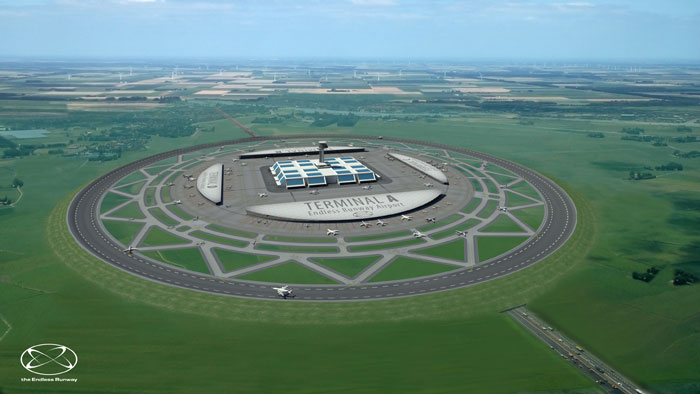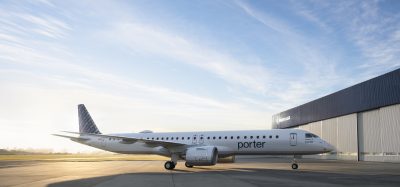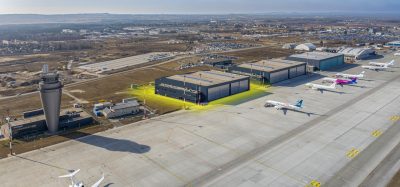Circular runway exclusive: The reality behind the revolutionary project
- Like
- Digg
- Del
- Tumblr
- VKontakte
- Buffer
- Love This
- Odnoklassniki
- Meneame
- Blogger
- Amazon
- Yahoo Mail
- Gmail
- AOL
- Newsvine
- HackerNews
- Evernote
- MySpace
- Mail.ru
- Viadeo
- Line
- Comments
- Yummly
- SMS
- Viber
- Telegram
- Subscribe
- Skype
- Facebook Messenger
- Kakao
- LiveJournal
- Yammer
- Edgar
- Fintel
- Mix
- Instapaper
- Copy Link
Posted: 23 March 2017 | Henk Hesselink, International Airport Review | 8 comments
The ‘Endless Runway’ project is undoubtedly revolutionary and International Airport Review spoke to the project’s Senior R&D Manager Henk Hesselink for an exclusive insight.


Henk Hesselink, Senior R&D Manager, Netherlands Aerospace Centre (NLR)
Will the circular runway ever truly take off? Might circular runways solve aviation’s environmental challenges? ‘The Endless Runway‘ project, led by a team of Dutch scientists from the Netherlands Aerospace Centre (NLR) essentially presents the space-saving, emission-reducing concept of a circular runway best articulated in image form as you can see. The project and idea is undoubtedly revolutionary and to find out more International Airport Review spoke exclusively to Senior R&D Manager Henk Hesselink for a behind-the-scenes insight.
1. The ‘Endless Runway’ project sounds extremely ambitious… what is it?
The Endless Runway is a radical idea for a new concept of operating a runway that affects the operations and construction of the whole airport.
NLR led a consortium of research centres that investigated the idea of a circular runway. The work has been carried out with partners in The Netherlands, Germany, France, Spain and Poland. The work was partly funded by the Framework 7 programme of the European Commission. The European Commission recognises that mobility will be stressed the next decades and that new breaking technology will be necessary.


Passengers during take-off or landing will not feel like they are in a roller coaster
This runway is a circle, that has no limitations on where to take-off or land on this circle. This makes it possible to fly in from or out to any direction. The size of the circle is pretty large, its diameter is 3.5 kilometres. Total length of the runway therefore is 10 km. This means that passengers during take-off or landing will not feel like they are in a roller coaster, a maximum of 1.2g forces will be experienced, similar to a train on a curved track. A typical landing only requires a part of the runway with a limited curve.
Current airports operate runways with fixed directions, so a limited number of directions is available for take-off and landing. During a storm, the capacity of the runway is limited because of this. This fixed direction also means that some communities experience more noise than others.
At the Endless Runway, aircraft have the possibility to land anywhere on the circle. This gives the possibility to find always at least one point where there is no crosswind and only headwind. This means that the airport can operate a sustainable capacity.
2. In light of the very exciting announcements that the circular runway might solve several issues, how would it physically work?
The aircraft will take-off at the point where there is no crosswind. In limited wind conditions, aircraft can take-off and land anywhere on the circle. This makes it possible that an optimum point can be chosen, based on the origin of the landing aircraft or destination when taking off.
The runway is banked. Starting from the inner part of the circle on a flat surface, the bank angle will gradually increase to the outside. Because of the centrifugal forces a starting aircraft at the middle of the circle will move to the outer part until taking off.
The project is an innovative project that aims at solutions beyond 2050.
A landing aircraft will need to land at the part of the slope depending on its speed and will gradually move down when slowing down. If the aircraft lands too high, the shape of the runway will force it to go down quickly until the right path is found. The other way around, the aircraft will be forced to the outside if it lands too low. We calculated that the runway must be extended up to a width of 140 meters to allow this as a safe operation. Flight tests have been performed in the 1960s using military aircraft, where pilots reported that the runway was easy to use and the bank angle made them move to the right path quickly (It must be mentioned that the first landings were more uncertain for the pilots, but quickly they started to get accustomed to the curved track.
3. What are the precise benefits?
The capacity of an airport with an Endless Runway is at least similar to that of a conventional airport with four runways, while the length of the circular runway is comparable to three. This makes it possible to use the runway with several aircraft simultaneously.
Flight times in the area around the airport will be reduced as aircraft can now almost fly straight in and out. Having said this, it will be possible to avoid large communities. We will be able to design routes that avoid the areas where most people live. Or we can design routes such that everyone around the airfield will experience a similar level of noise. Agreements can be made.
Another advantage of the concept is that the airport buildings can be constructed in the middle of the circle, reducing the size of the airport. We have estimated that a large airfield like the airfield of Paris will fit within the circle, which occupies an area of about one third of the size of the current airport.
4. Are there any obstacles to the project – challenges that you might face?
Costs for constructing the airport will be higher than currently. The amount of concrete necessary will be larger than for normal runways as the width is larger. Besides, the construction will be more complex because of the bank angle. We estimated the airport to be about 1.5 times the costs of a conventional.
Using flight trials, we will be able to control circumstances
Major challenges are the safety aspects. Up to now, we have taken safety as a basis for all our simulations and calculations. Most responses I receive however concern the safety. As NLR we always demand safety at the highest level and we need to take a step-by-step approach to keep ensuring that the operation remains safe. In follow on steps, with flight trials we will further investigate all possible safety aspects. Using flight trials, we will be able to control circumstances and further test all safety issues.
5. What is the current situation regarding development on the project?
Within the project, we have designed a concept, procedures and we made a design for the airport. We have performed simulations, using a PC-based flight simulator and we used an air traffic control simulator to find out where we need to adapt current operations and procedures and what new developments will be necessary. We checked the take-off and landing under the most constrained situations with a B747 simulation.
An Endless Runway is at least similar to that of a conventional airport with four runways.
We also designed an aircraft that would be optimised for use of the Endless Runway, based on future aircraft developments. We also carried out simulations in an ATC simulation where, again, we took a very constrained situation: we considered the busiest day of the year at Paris CDG airport to find out if is possible to handle all traffic on the circular runway. This was possible. It will be necessary to construct new controller assistance tools for planning traffic that comes from and flies out in all directions. We made a first design for such planning tools.
6. When is the realistic first date for the first circular runway you hope?
The project is an innovative project that aims at solutions beyond 2050. But with all attention that we receive now, I do hope that the topic is taken up at faster pace. It will certainly take many years, but my optimistic guess would be in about 20 years.
7. What does 2017 hold for the project?
We want to give the current PC-simulations a follow on with performing flight trials. Using drones on an existing curved track, like a car test track, will allow fast and safe possibilities for testing.
We receive a lot of attention with the publication of the Endless Runway video and we will take the responses that we receive seriously. Many people question the behaviour of the aircraft in approach to the circular runway. This is exactly what we want to address in a follow on study. Up to now, we have address all issues, including safety matters, in a simulation environment. We have received a lot of results and all design decisions have been taken based on the results of the simulations.
Watch the video here courtesy of the BBC.
The next step will be to perform actual flight tests. First for the standard behaviour of the aircraft on the Endless Runway during take-off and landing. We need to perform several flights to test many different operational circumstances. Specifically under different weather conditions. Next to this we want to test emergency procedures. In a controlled environment with pre-planned situations, we will be able to perform all kinds of emergencies during each phase of flight.
Many people question the behaviour of the aircraft in approach to the circular runway.
We envisage that these tests can be performed using drones. Not with the small quadcopters, but large fixed wing drones (up to e.g. 300 kg.). These drones can be tested at existing circular tracks, like test tracks for cars.
After these tests, we can perform manned flights and after this, it will be good to develop real runways, exactly as we have calculated them to be in the study and based on the flight trials. We keep developing the runway, always keeping safety in mind. And once the runways have been tested, we can start operational tests with real runways and real airports. This will take a time frame of several decades; as mentioned before, the study of the Endless Runway was for the year 2050 and beyond.
With these steps, we will be able to bring the research to the next test level and finally the operational level.
For more information, visit the ‘Endless Runway’ project website.
What do you think about the circular runway project? Is it a genuine revolution or an overambitious science project? As ever, feel free to comment and share your thoughts with International Airport Review.
Related topics
Aeronautical revenue, Airport development, Capacity, Economy, Emissions, Runways and pavements, Sustainability, Sustainable development


















Airplanes are symmetrically shaped along the axis of straight horizontal landing. Using inclined runway could raise the following questions:
1- Would gear Touchdown puts a first pressure on right side gears more than left gears (assuming rotating counter clock wise on the runway)
2- Would it affect if wingtip right vortex is higher than left one on the runway?
3- Will fluids (such as stored fuel) cause imbalance on an inclined runway
4- Is belly Landing possible on such a runway?
5- Would crosswind landing (assuming wind direction is outwards), cause right gears touch land before left gears?
Other issues:
1- Review all past history of airplane accidents related to runway takeoff and landing. What would have been the accident scenario if the runway was circular and tilted?
2- The airport could be flooded as the inclined runway brings falling rain inside.
3- Could wind and rain bring sand, mud and small stones from outside the runway ring inside and they slides downwards?
What is the date today – “oh” Saturday is April 1st!!
for a circular motion two forces has to balance each other one is centripetal and other is centrifugal
every particle touching at a circular line will tend to fly off tangentially
what will cause the aircraft to move along a circular path at such a high speed and during landing have more of balancing attracting centripetal force and for take off flying out and up tangentially
what surface balancing and bogie settings will be?
Interesting idea – but beyond the yet above (or below this comment) mentioned issues: How will navigational techniques like Instrument Landing Systems work? As far as i understood airplanes could approach from any direction directly to their touch-down-points. Which would mean the neccesity of ILSses from more or less at least 360 points of the runway radial, isn’t it?
Or will be just a centric ILS emitted – but what would that mean for the minimum decision height? From which height this would only allow visual instead of instrumental approaches?
Surely it would technically possible to emit 360 vertical and horizontal rays for an approach – but doesn’t this mean an effort to install more or less 360 systems instead of four – set an airport with ILS with two parallel bidirectional runways? And how should this issue lead to “only” the factor of 1,5 in the constructional costs in comparison with “conventional” todays airports???
Not an engineer, but I’ve flown in large and light aircraft…. One of the biggest problems here is landing. The pilot has to fly an approach that is curved, and maintain that curve.
Rather than having the runway stretching out in front of him and simply having to hold course, the runway is constantly curving away from him and he has to adjust all the time. There is increased danger of overshooting, because while he cannot run out of length on a circular runway (in theory!), he can run out of width very easily because he is trying to keep within the bounds of a space, in which one wall is constantly looming at him from one side.
The second problem with landing is approach speed. Airliners land at around 150mph or higher. Rather than having the runway stretched out ahead, the pilot in this scenario is effectively at increased risk of slamming the plane into a wall: unless he exactly matches the flightpath of his aircraft to the curvature of the runway, he’s running out of room fast. This isn’t like the gentle curve beneath a ski jump where gravity and the curve combine to give the jumper a smooth approach.
There are also issues with roll – on a flat runway, if a wingtip dips, there is space beneath to accommodate the dip without the wingtip hitting ground. In this scenario, the space on the port side is much reduced.
This simply isn’t a goer.
This is certainly an interesting solution when it comes to land use. An important issue in terms of sustainability. But the financial cost will be higher.. and with greater consumption of natural resources.
And not so technically convincing. Landing an aircraft is tricky, even for an experienced pilot, and thiis endless runway will certainly not make it easier.
Well I do like the idea although I would suggest that with a 3 kilometer diameter there isn’t a big space saving and with unknown limits on varying elevations within that space, a hunt for sites might be an issue. The close in and low approach orientation and the associated obstacle clearances have traditionally been designed on a constant heading most usually associate with a particular runway direction. This design will provide some interesting challenges for the development of new models for instrument guidance, approach lighting and runway lighting all of which are critical for the successful transition from the instrument environment to the visual of the airport environment. The whole process is designed to have us arrive at a particular spot in a particular and stable configuration with wings level. To contemplate briefing an approach for the first time into an airport where one will have to initiate a banked turn at touchdown from 200 ft and a half mile vis has to give one pause.
A very good and thoughtful idea. Though I am in favour of this idea but what does not appeal me is how would passengers enter the airport and what about the parking area??